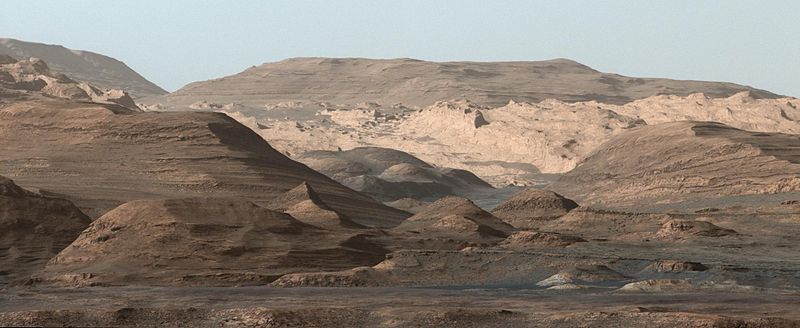Curiosity (rover): Difference between revisions
Undo |
I have edited the article by moving entire sections into a more logical order starting with the mission and its objectives. The crafts specifications don't need to be in two sections, likewise once the landing happened, the rover is on the surface and its mission started. The other half of the article remains the same: a section on instruments, its legacy and images. |
||
| Line 50: | Line 50: | ||
'''''Curiosity''''' is a [[car]]-sized [[rover (space exploration)|rover]] designed to [[Space exploration|explore]] [[Gale (crater)|the crater Gale]] on [[Mars]] as part of [[NASA]]'s [[Mars Science Laboratory]] mission (MSL).<ref name="NASA-Curiosity" /> ''Curiosity'' was launched from [[Cape Canaveral Air Force Station|Cape Canaveral]] on November 26th, 2011, at 15:02 UTC and landed on [[Aeolis Palus]] inside Gale on Mars on August 6th, 2012, 05:17 UTC.<ref name="Abilleira2013" /><ref name="bbc20120808" /><ref name="youtube1" /> The [[Bradbury Landing]] site was less than {{convert|2.4|km|abbr=on}} from the center of the rover's touchdown target after a {{convert|35|e6mi|e6km|abbr=unit|order=flip}} journey.<ref name="NASA-20120822" /><ref name="autogenerated1" /> The rover's [[#Goals and objectives|goals]] include an investigation of the Martian [[climate of Mars|climate]] and [[geology of Mars|geology]]; assessment of whether the selected field site inside Gale has ever offered [[environmental science|environmental conditions]] favorable for [[Life on Mars|microbial life]], including investigation of the [[Water on Mars|role of water]]; and [[planetary habitability]] studies in preparation for human exploration.<ref name="overview" /><ref name="goals" /> |
'''''Curiosity''''' is a [[car]]-sized [[rover (space exploration)|rover]] designed to [[Space exploration|explore]] [[Gale (crater)|the crater Gale]] on [[Mars]] as part of [[NASA]]'s [[Mars Science Laboratory]] mission (MSL).<ref name="NASA-Curiosity" /> ''Curiosity'' was launched from [[Cape Canaveral Air Force Station|Cape Canaveral]] on November 26th, 2011, at 15:02 UTC and landed on [[Aeolis Palus]] inside Gale on Mars on August 6th, 2012, 05:17 UTC.<ref name="Abilleira2013" /><ref name="bbc20120808" /><ref name="youtube1" /> The [[Bradbury Landing]] site was less than {{convert|2.4|km|abbr=on}} from the center of the rover's touchdown target after a {{convert|35|e6mi|e6km|abbr=unit|order=flip}} journey.<ref name="NASA-20120822" /><ref name="autogenerated1" /> The rover's [[#Goals and objectives|goals]] include an investigation of the Martian [[climate of Mars|climate]] and [[geology of Mars|geology]]; assessment of whether the selected field site inside Gale has ever offered [[environmental science|environmental conditions]] favorable for [[Life on Mars|microbial life]], including investigation of the [[Water on Mars|role of water]]; and [[planetary habitability]] studies in preparation for human exploration.<ref name="overview" /><ref name="goals" /> |
||
In December 2012, ''Curiosity''{{'s}} two-year mission was extended indefinitely,<ref name="3news.nz" /> and on August 5th, 2017, NASA celebrated the fifth anniversary of the ''Curiosity'' rover landing.<ref name="NASA-20170802" /><ref name="SP-20170805" /> The rover is still operational, and as of {{CURRENTMONTHNAME}} {{CURRENTDAY}}, {{CURRENTYEAR}}, ''Curiosity'' has been on the [[Mars|planet Mars]] for {{Curiosity Mission Timer}} [[Martian day|sols]] ({{time interval|6 August 2012 05:17:57|show=d|disp=raw}} [[day|total days]]) since landing on August 6th, 2012. ''(See [[Timeline of Mars Science Laboratory#Current status|current status]].)'' |
In December 2012, ''Curiosity''{{'s}} two-year mission was extended indefinitely,<ref name="3news.nz" /> and on August 5th, 2017, NASA celebrated the fifth anniversary of the ''Curiosity'' rover landing.<ref name="NASA-20170802" /><ref name="SP-20170805" /> The rover is still operational, and as of {{CURRENTMONTHNAME}} {{CURRENTDAY}}, {{CURRENTYEAR}}, ''Curiosity'' has been on the [[Mars|planet Mars]] for {{Curiosity Mission Timer}} [[Martian day|sols]] ({{time interval|6 August 2012 05:17:57|show=d|disp=raw}} [[day|total days]]) since landing on August 6th, 2012. ''(See [[Timeline of Mars Science Laboratory#Current status|current status]].)'' The NASA/JPL [[Mars Science Laboratory]]/''Curiosity'' Project Team was awarded the 2012 [[Robert J. Collier Trophy]] by the [[National Aeronautic Association]] "In recognition of the extraordinary achievements of successfully landing ''Curiosity'' on Mars, advancing the nation's technological and engineering capabilities, and significantly improving humanity's understanding of ancient Martian habitable environments."<ref name="NAA-20130312" /> |
||
''Curiosity''{{'s}} design |
''Curiosity''{{'s}} rover design will serve as the basis for NASA's 2021 [[Perseverance (rover)|''Perseverance'' mission]] which will carry different scientific instruments. |
||
== Goals and objectives == |
==Mission== |
||
=== Goals and objectives === |
|||
[[File:Mars Science Laboratory Curiosity Rover Animation.webm|right|thumb|Animation of the ''Curiosity'' rover, showing its capabilities]] |
[[File:Mars Science Laboratory Curiosity Rover Animation.webm|right|thumb|Animation of the ''Curiosity'' rover, showing its capabilities]] |
||
As established by the [[Mars Exploration Program]], the main scientific goals of the MSL mission are to help determine whether Mars could ever have supported [[life on Mars|life]], as well as determining the [[Water on Mars|role of water]], and to study the [[climate of Mars|climate]] and [[geology of Mars]].<ref name="overview" /><ref name="goals" /> The mission results will also help prepare for human exploration.<ref name="goals" /> To contribute to these goals, MSL has eight main scientific objectives:<ref name="nasa.obj" /> |
As established by the [[Mars Exploration Program]], the main scientific goals of the MSL mission are to help determine whether Mars could ever have supported [[life on Mars|life]], as well as determining the [[Water on Mars|role of water]], and to study the [[climate of Mars|climate]] and [[geology of Mars]].<ref name="overview" /><ref name="goals" /> The mission results will also help prepare for human exploration.<ref name="goals" /> To contribute to these goals, MSL has eight main scientific objectives:<ref name="nasa.obj" /> |
||
| Line 79: | Line 80: | ||
</ol> |
</ol> |
||
About one year into the surface mission, and having assessed that ancient Mars could have been hospitable to microbial life, the MSL mission objectives evolved to developing predictive models for the preservation process of [[organic compound]]s and [[biomolecules]]; a branch of paleontology called [[taphonomy]].<ref name="Science 01-24-2014" /> |
About one year into the surface mission, and having assessed that ancient Mars could have been hospitable to microbial life, the MSL mission objectives evolved to developing predictive models for the preservation process of [[organic compound]]s and [[biomolecules]]; a branch of paleontology called [[taphonomy]].<ref name="Science 01-24-2014" /> The region it is set to explore has been compared to the [[Four Corners]] region of the North American west.<ref name="nasa.pia16068" /> |
||
| ⚫ | |||
| ⚫ | A [[NASA]] panel selected the name ''Curiosity'' following a nationwide student contest that attracted more than 9,000 proposals via the Internet and mail. A sixth-grade student from [[Kansas]], 12-year-old Clara Ma from Sunflower Elementary School in [[Lenexa, Kansas]], submitted the winning entry. As her prize, Ma won a trip to [[NASA]]'s [[Jet Propulsion Laboratory]] (JPL) in [[Pasadena, California]], where she signed her name directly onto the rover as it was being assembled.<ref name="NASA" /> |
||
| ⚫ | |||
| ⚫ | {{Quote|Curiosity is an everlasting flame that burns in everyone's mind. It makes me get out of bed in the morning and wonder what surprises life will throw at me that day. Curiosity is such a powerful force. Without it, we wouldn't be who we are today. Curiosity is the passion that drives us through our everyday lives. We have become explorers and scientists with our need to ask questions and to wonder.<ref name="NASA" />}} |
||
=== Rover and lander specifications === |
|||
| ⚫ | |||
| ⚫ | [[File:PIA15279 3rovers-stand D2011 1215 D521.jpg|thumb|400px|Two Jet Propulsion Laboratory engineers stand with three vehicles, providing a size comparison of three generations of Mars rovers. Front and center is the flight spare for the first Mars rover, ''Sojourner'', which landed on Mars in 1997 as part of the Mars Pathfinder Project. On the left is a Mars Exploration Rover (MER) test vehicle that is a working sibling to ''Spirit'' and ''Opportunity'', which landed on Mars in 2004. On the right is a test rover for the Mars Science Laboratory, which landed ''Curiosity'' on Mars in 2012.{{paragraph break}} ''Sojourner'' is {{convert|65|cm|ft|abbr=on}} long. The Mars Exploration Rovers (MER) are {{convert|1.6|m|ft|abbr=on}} long. ''Curiosity'' on the right is {{convert|3|m|ft|abbr=on}} long.]] |
||
| ⚫ | ''Curiosity'' is {{convert|2.9|m|ft|abbr=on}} long by {{convert|2.7|m|ft|abbr=on}} wide by {{convert|2.2|m|ft|abbr=on}} in height,<ref name="cnes" /> larger than Mars Exploration Rovers, which are {{convert|1.5|m|ft|abbr=on}} long and have a mass of {{convert|174|kg|lb|abbr=on}} including {{convert|6.8|kg|lb|abbr=on}} of scientific instruments.<ref name="MSLUSAToday" /><ref name="Mars Rovers: Pathfinder, MER (Spirit and Opportunity), and MSL" /><ref name="Mars Exploration Rover Launches" /> In comparison to [[Pancam]] on the Mars Exploration Rovers, the MastCam-34 has 1.25× higher [[Angular resolution|spatial resolution]] and the MastCam-100 has 3.67× higher spatial resolution.<ref name="MastCamDescription" /> |
||
| ⚫ | ''Curiosity'' has an advanced [[Payload (air and space craft)|payload]] of scientific equipment on Mars.<ref name="facts" /> It is the fourth NASA robotic rover sent to Mars since 1996. Previous successful Mars rovers are ''[[Sojourner (rover)|Sojourner]]'' from the [[Mars Pathfinder]] mission (1997), and ''[[Spirit (rover)|Spirit]]'' (2004–2010) and ''[[Opportunity (rover)|Opportunity]]'' (2004–2019) rovers from the [[Mars Exploration Rover]] mission. |
||
== Specifications == |
|||
''Curiosity'' comprised 23% of the mass of the {{convert|3893|kg|lb|abbr=on}} spacecraft at launch. The remaining mass was discarded in the process of transport and landing. |
''Curiosity'' comprised 23% of the mass of the {{convert|3893|kg|lb|abbr=on}} spacecraft at launch. The remaining mass was discarded in the process of transport and landing. |
||
* '''Dimensions''': ''Curiosity'' has a mass of {{convert|899|kg|lb|abbr=on}} including {{convert|80|kg|lb|abbr=on}} of scientific instruments.<ref name="MSLUSAToday" /> The rover is {{convert|2.9|m|ft|abbr=on}} long by {{convert|2.7|m|ft|abbr=on}} wide by {{convert|2.2|m|ft|abbr=on}} in height.<ref name="cnes" /> |
* '''Dimensions''': ''Curiosity'' has a mass of {{convert|899|kg|lb|abbr=on}} including {{convert|80|kg|lb|abbr=on}} of scientific instruments.<ref name="MSLUSAToday" /> The rover is {{convert|2.9|m|ft|abbr=on}} long by {{convert|2.7|m|ft|abbr=on}} wide by {{convert|2.2|m|ft|abbr=on}} in height.<ref name="cnes" /> |
||
| Line 104: | Line 119: | ||
:''Curiosity'' can roll over obstacles approaching {{convert|65|cm|in|abbr=on}} in height,<ref name="facts" /> and it has a ground clearance of {{convert|60|cm|in|abbr=on}}.<ref name="first drive" /> Based on variables including power levels, terrain difficulty, slippage and visibility, the maximum terrain-traverse speed is estimated to be {{convert|200|m|ft|abbr=on}} per day by automatic navigation.<ref name="facts" /> The rover landed about {{convert|10|km|mi|abbr=on}} from the base of Mount Sharp,<ref name="stuff-7437621" /> (officially named [[Aeolis Mons]]) and it is expected to traverse a minimum of {{convert|19|km|mi|abbr=on}} during its primary two-year mission.<ref name="home" /> It can travel up to {{convert|90|m|ft|abbr=on}} per hour but average speed is about {{convert|30|m|ft|abbr=on}} per hour.<ref name="home" /> The vehicle is 'driven' by several operators led by [[Vandi Verma]], group leader of Autonomous Systems, Mobility and Robotic Systems at JPL,<ref name="rg2019" /><ref name="jpl2019" /> who also cowrote the [[PLEXIL]] language used to operate the rover.<ref name="ntrs2019" /><ref name="plex2019" /><ref name="nasaapps" /> |
:''Curiosity'' can roll over obstacles approaching {{convert|65|cm|in|abbr=on}} in height,<ref name="facts" /> and it has a ground clearance of {{convert|60|cm|in|abbr=on}}.<ref name="first drive" /> Based on variables including power levels, terrain difficulty, slippage and visibility, the maximum terrain-traverse speed is estimated to be {{convert|200|m|ft|abbr=on}} per day by automatic navigation.<ref name="facts" /> The rover landed about {{convert|10|km|mi|abbr=on}} from the base of Mount Sharp,<ref name="stuff-7437621" /> (officially named [[Aeolis Mons]]) and it is expected to traverse a minimum of {{convert|19|km|mi|abbr=on}} during its primary two-year mission.<ref name="home" /> It can travel up to {{convert|90|m|ft|abbr=on}} per hour but average speed is about {{convert|30|m|ft|abbr=on}} per hour.<ref name="home" /> The vehicle is 'driven' by several operators led by [[Vandi Verma]], group leader of Autonomous Systems, Mobility and Robotic Systems at JPL,<ref name="rg2019" /><ref name="jpl2019" /> who also cowrote the [[PLEXIL]] language used to operate the rover.<ref name="ntrs2019" /><ref name="plex2019" /><ref name="nasaapps" /> |
||
== |
=== Landing === |
||
| ⚫ | |||
| ⚫ | ''Curiosity'' landed in Quad 51 (nicknamed Yellowknife) of [[Aeolis Palus]] in the crater Gale.<ref name="NASA-20120810" /><ref name="NASA-20120809" /><ref name="BBC-20120809" /><ref name="USA-20120809" /> The landing site coordinates are: {{coord|4.5895|S|137.4417|E|globe:Mars}}.<ref name="MSNBC-20120806" /><ref name="S&T-20120807" /> The location was named [[Bradbury Landing]] on August 22, 2012, in honor of science fiction author [[Ray Bradbury]].<ref name="NASA-20120822" /> Gale, an estimated 3.5 to 3.8 billion-year-old impact crater, is hypothesized to have first been gradually filled in by [[sediment]]s; first water-deposited, and then wind-deposited, possibly until it was completely covered. Wind [[erosion]] then scoured out the sediments, leaving an isolated {{convert|5.5|km|mi|adj=mid|-high|sp=us}} mountain, [[Aeolis Mons]] ("Mount Sharp"), at the center of the {{convert|154|km|abbr=on}} wide crater. Thus, it is believed that the rover may have the opportunity to study two billion years of Martian history in the sediments exposed in the mountain. Additionally, its landing site is near an [[alluvial fan]], which is hypothesized to be the result of a flow of ground water, either before the deposition of the eroded sediments or else in relatively recent geologic history.<ref name="Crater mound a prize and puzzle for Mars rover" /><ref name="themis" /> |
||
| ⚫ | |||
| ⚫ | |||
| ⚫ | |||
| ⚫ | |||
| ⚫ | |||
| ⚫ | |||
| ⚫ | |||
| ⚫ | |||
| ⚫ | ''Curiosity'' transformed from its stowed flight configuration to a landing configuration while the MSL spacecraft simultaneously lowered it beneath the spacecraft descent stage with a {{convert|20|m|abbr=on}} tether from the "sky crane" system to a soft landing—wheels down—on the surface of Mars.<ref name="EntryDescentLanding" /><ref name="Sky Crane – how to land Curiosity on the surface of Mars" /><ref name="Mars rover lands on Xbox Live" /><ref name="Mars Science Laboratory: Entry, Descent, and Landing System Performance" /> After the rover touched down it waited 2 seconds to confirm that it was on solid ground then fired several [[pyrotechnic fastener]]s activating cable cutters on the bridle to free itself from the spacecraft descent stage. The descent stage then flew away to a crash landing, and the rover prepared itself to begin the science portion of the mission.<ref name="ellipse" /> |
||
=== Daily operations === |
|||
| ⚫ | On April 16, 2020, the rover is now 13.66 miles away from its landing site.<ref>{{Cite web|url=https://an.rsl.wustl.edu/msl/mslbrowser/an3.aspx|title=MSL Notebook - Curiosity Mars Rover data|website=an.rsl.wustl.edu|access-date=2020-04-20}}</ref> The rover spends a lot of its time idle because it will stop and spend extended periods of time at major science waypoints. As of April 17, 2020, the rover has been driven on less than 800 out of 2736 [[Sol (day on Mars)|sols]] (Martian days). |
||
| ⚫ | Communication with the rover is not instantaneous. There is a delay in transmitting commands to the rover, and there is a delay receiving imagery back from the rover. Depending on the distance between Earth and Mars, the delay is between 4 to 24 minutes, and averages 14 minutes. As a result, navigation is done by sending a command such as "drive forward X distance" or "drive toward X place", and the rover will use its cameras and computers to drive to those locations autonomously. |
||
== Scientific instruments == |
|||
[[File:Drawing-of-the-Mars-Science Laboratory.png|thumb|350px|Instrument location diagram]] |
[[File:Drawing-of-the-Mars-Science Laboratory.png|thumb|350px|Instrument location diagram]] |
||
The general sample analysis strategy begins with high-resolution cameras to look for features of interest. If a particular surface is of interest, ''Curiosity'' can vaporize a small portion of it with an infrared laser and examine the resulting spectra signature to query the rock's elemental composition. If that signature is intriguing, the rover uses its long arm to swing over a [[Mars Hand Lens Imager|microscope]] and an [[X-ray spectroscopy|X-ray spectrometer]] to take a closer look. If the specimen warrants further analysis, ''Curiosity'' can drill into the boulder and deliver a powdered sample to either the [[Sample Analysis at Mars|SAM]] or the [[CheMin]] analytical laboratories inside the rover.<ref name="Gale Crater: Geological 'sweet shop' awaits Mars rover" /><ref name="MSLSAM" /><ref name="nasa2" /> The MastCam, Mars Hand Lens Imager (MAHLI), and Mars Descent Imager (MARDI) cameras were developed by [[Malin Space Science Systems]] and they all share common design components, such as on-board electronic [[image processing|imaging processing]] boxes, 1600×1200 [[Charge-coupled device|CCDs]], and an [[Bayer filter|RGB Bayer pattern filter]].<ref name="LPSCMast" /><ref name="MastCam" /><ref name="MAHLI" /><ref name="MARDI" /><ref name="MastCamDescription" /><ref name="NovEmail" /> |
The general sample analysis strategy begins with high-resolution cameras to look for features of interest. If a particular surface is of interest, ''Curiosity'' can vaporize a small portion of it with an infrared laser and examine the resulting spectra signature to query the rock's elemental composition. If that signature is intriguing, the rover uses its long arm to swing over a [[Mars Hand Lens Imager|microscope]] and an [[X-ray spectroscopy|X-ray spectrometer]] to take a closer look. If the specimen warrants further analysis, ''Curiosity'' can drill into the boulder and deliver a powdered sample to either the [[Sample Analysis at Mars|SAM]] or the [[CheMin]] analytical laboratories inside the rover.<ref name="Gale Crater: Geological 'sweet shop' awaits Mars rover" /><ref name="MSLSAM" /><ref name="nasa2" /> The MastCam, Mars Hand Lens Imager (MAHLI), and Mars Descent Imager (MARDI) cameras were developed by [[Malin Space Science Systems]] and they all share common design components, such as on-board electronic [[image processing|imaging processing]] boxes, 1600×1200 [[Charge-coupled device|CCDs]], and an [[Bayer filter|RGB Bayer pattern filter]].<ref name="LPSCMast" /><ref name="MastCam" /><ref name="MAHLI" /><ref name="MARDI" /><ref name="MastCamDescription" /><ref name="NovEmail" /> |
||
| Line 219: | Line 258: | ||
Since early 2015 the percussive mechanism in the drill that helps chisel into rock has had an intermittent electrical short.<ref name="drill-fault" /> On December 1, 2016, the motor inside the drill caused a malfunction that prevented the rover from moving its robotic arm and driving to another location.<ref name="popmech20161213" /> The fault was isolated to the drill feed brake,<ref name="spacecom20161215" /> and internal debris is suspected of causing the problem.<ref name="drill-fault" /> By December 9, driving and robotic arm operations were cleared to continue, but drilling remained suspended indefinitely.<ref name="nasa20161209" /> The ''Curiosity'' team continued to perform diagnostics and testing on the drill mechanism throughout 2017,<ref name="planetary20170906" /> and resumed drilling operations on May 22, 2018.<ref name="drillingagain" /> |
Since early 2015 the percussive mechanism in the drill that helps chisel into rock has had an intermittent electrical short.<ref name="drill-fault" /> On December 1, 2016, the motor inside the drill caused a malfunction that prevented the rover from moving its robotic arm and driving to another location.<ref name="popmech20161213" /> The fault was isolated to the drill feed brake,<ref name="spacecom20161215" /> and internal debris is suspected of causing the problem.<ref name="drill-fault" /> By December 9, driving and robotic arm operations were cleared to continue, but drilling remained suspended indefinitely.<ref name="nasa20161209" /> The ''Curiosity'' team continued to perform diagnostics and testing on the drill mechanism throughout 2017,<ref name="planetary20170906" /> and resumed drilling operations on May 22, 2018.<ref name="drillingagain" /> |
||
== |
== Media, cultural impact and legacy == |
||
| ⚫ | [[File:PIA15279 3rovers-stand D2011 1215 D521.jpg|thumb |
||
| ⚫ | ''Curiosity'' has an advanced [[Payload (air and space craft)|payload]] of scientific equipment on Mars.<ref name="facts" /> It is the fourth NASA robotic rover sent to Mars since 1996. Previous successful Mars rovers are ''[[Sojourner (rover)|Sojourner]]'' from the [[Mars Pathfinder]] mission (1997), and ''[[Spirit (rover)|Spirit]]'' (2004–2010) and ''[[Opportunity (rover)|Opportunity]]'' (2004–2019) rovers from the [[Mars Exploration Rover]] mission. |
||
| ⚫ | ''Curiosity'' is {{convert|2.9|m|ft|abbr=on}} long by {{convert|2.7|m|ft|abbr=on}} wide by {{convert|2.2|m|ft|abbr=on}} in height,<ref name="cnes" /> larger than Mars Exploration Rovers, which are {{convert|1.5|m|ft|abbr=on}} long and have a mass of {{convert|174|kg|lb|abbr=on}} including {{convert|6.8|kg|lb|abbr=on}} of scientific instruments.<ref name="MSLUSAToday" /><ref name="Mars Rovers: Pathfinder, MER (Spirit and Opportunity), and MSL" /><ref name="Mars Exploration Rover Launches" /> In comparison to [[Pancam]] on the Mars Exploration Rovers, the MastCam-34 has 1.25× higher [[Angular resolution|spatial resolution]] and the MastCam-100 has 3.67× higher spatial resolution.<ref name="MastCamDescription" /> |
||
The region the rover is set to explore has been compared to the [[Four Corners]] region of the North American west.<ref name="nasa.pia16068" /> |
|||
<br /> |
|||
| ⚫ | |||
{{clear}} |
|||
== The name: ''Curiosity'' == |
|||
| ⚫ | A [[NASA]] panel selected the name ''Curiosity'' following a nationwide student contest that attracted more than 9,000 proposals via the Internet and mail. A sixth-grade student from [[Kansas]], |
||
| ⚫ | |||
| ⚫ | {{Quote|Curiosity is an everlasting flame that burns in everyone's mind. It makes me get out of bed in the morning and wonder what surprises life will throw at me that day. Curiosity is such a powerful force. Without it, we wouldn't be who we are today. Curiosity is the passion that drives us through our everyday lives. We have become explorers and scientists with our need to ask questions and to wonder.<ref name="NASA" />}} |
||
== Landing == |
|||
=== Landing site === |
|||
| ⚫ | |||
| ⚫ | ''Curiosity'' landed in Quad 51 (nicknamed Yellowknife) of [[Aeolis Palus]] in the crater Gale.<ref name="NASA-20120810" /><ref name="NASA-20120809" /><ref name="BBC-20120809" /><ref name="USA-20120809" /> The landing site coordinates are: {{coord|4.5895|S|137.4417|E|globe:Mars}}.<ref name="MSNBC-20120806" /><ref name="S&T-20120807" /> The location was named [[Bradbury Landing]] on August 22, 2012, in honor of science fiction author [[Ray Bradbury]].<ref name="NASA-20120822" /> Gale, an estimated 3.5 to 3.8 billion-year-old impact crater, is hypothesized to have first been gradually filled in by [[sediment]]s; first water-deposited, and then wind-deposited, possibly until it was completely covered. Wind [[erosion]] then scoured out the sediments, leaving an isolated {{convert|5.5|km|mi|adj=mid|-high|sp=us}} mountain, [[Aeolis Mons]] ("Mount Sharp"), at the center of the {{convert|154|km|abbr=on}} wide crater. Thus, it is believed that the rover may have the opportunity to study two billion years of Martian history in the sediments exposed in the mountain. Additionally, its landing site is near an [[alluvial fan]], which is hypothesized to be the result of a flow of ground water, either before the deposition of the eroded sediments or else in relatively recent geologic history.<ref name="Crater mound a prize and puzzle for Mars rover" /><ref name="themis" /> |
||
| ⚫ | |||
| ⚫ | |||
| ⚫ | |||
| ⚫ | |||
| ⚫ | |||
| ⚫ | |||
| ⚫ | |||
| ⚫ | |||
| ⚫ | ''Curiosity'' transformed from its stowed flight configuration to a landing configuration while the MSL spacecraft simultaneously lowered it beneath the spacecraft descent stage with a {{convert|20|m|abbr=on}} tether from the "sky crane" system to a soft landing—wheels down—on the surface of Mars.<ref name="EntryDescentLanding" /><ref name="Sky Crane – how to land Curiosity on the surface of Mars" /><ref name="Mars rover lands on Xbox Live" /><ref name="Mars Science Laboratory: Entry, Descent, and Landing System Performance" /> After the rover touched down it waited 2 seconds to confirm that it was on solid ground then fired several [[pyrotechnic fastener]]s activating cable cutters on the bridle to free itself from the spacecraft descent stage. The descent stage then flew away to a crash landing, and the rover prepared itself to begin the science portion of the mission.<ref name="ellipse" /> |
||
== Typical day == |
|||
The rover will stop and spend extended periods of time at major science waypoints. As of April 17, 2020, the rover has been driven on less than 800 out of 2736 [[Sol (day on Mars)|sols]] (Martian days). |
|||
The rover spends a lot of its time idle. |
|||
| ⚫ | Communication with the rover is not instantaneous. There is a delay in transmitting commands to the rover, and there is a delay receiving imagery back from the rover. Depending on the distance between Earth and Mars, the delay is between 4 to 24 minutes, and averages 14 minutes. As a result, navigation is done by sending a command such as "drive forward X distance" or "drive toward X place", and the rover will use its cameras and computers to drive to those locations autonomously. |
||
| ⚫ | |||
== Coverage, cultural impact and legacy == |
|||
[[File:Cheering-full-br2.jpg|thumb|Celebration erupts at NASA with the rover's successful landing on Mars (August 6, 2012).]] |
[[File:Cheering-full-br2.jpg|thumb|Celebration erupts at NASA with the rover's successful landing on Mars (August 6, 2012).]] |
||
[[File:President Obama Phones Mars Rover Team.jpg|thumb|President [[Barack Obama]] congratulates NASA's ''Curiosity'' team (August 13, 2012).<ref name="NYT-20120813" />]] |
[[File:President Obama Phones Mars Rover Team.jpg|thumb|President [[Barack Obama]] congratulates NASA's ''Curiosity'' team (August 13, 2012).<ref name="NYT-20120813" />]] |
||
| ⚫ | |||
Live video showing the first footage from the surface of Mars was available at [[NASA TV]], during the late hours of August 6, 2012 PDT, including interviews with the mission team. The NASA website momentarily became unavailable from the overwhelming number of people visiting it,<ref name="Lands" /> and a 13-minute NASA excerpt of the landings on its YouTube channel was halted an hour after the landing by an automated [[DMCA]] takedown notice from [[E. W. Scripps Company|Scripps Local News]], which prevented access for several hours.<ref name="vice" /> Around 1,000 people gathered in New York City's [[Times Square]], to watch NASA's live broadcast of ''Curiosity''{{'s}} landing, as footage was being shown on the giant screen.<ref name="TimeSquare" /> [[Bobak Ferdowsi]], Flight Director for the landing, became an [[Internet meme]] and attained Twitter celebrity status, with 45,000 new followers subscribing to his Twitter account, due to his [[Mohawk hairstyle]] with yellow stars that he wore during the televised broadcast.<ref name="space" /><ref name="venturebeat" /> |
Live video showing the first footage from the surface of Mars was available at [[NASA TV]], during the late hours of August 6, 2012 PDT, including interviews with the mission team. The NASA website momentarily became unavailable from the overwhelming number of people visiting it,<ref name="Lands" /> and a 13-minute NASA excerpt of the landings on its YouTube channel was halted an hour after the landing by an automated [[DMCA]] takedown notice from [[E. W. Scripps Company|Scripps Local News]], which prevented access for several hours.<ref name="vice" /> Around 1,000 people gathered in New York City's [[Times Square]], to watch NASA's live broadcast of ''Curiosity''{{'s}} landing, as footage was being shown on the giant screen.<ref name="TimeSquare" /> [[Bobak Ferdowsi]], Flight Director for the landing, became an [[Internet meme]] and attained Twitter celebrity status, with 45,000 new followers subscribing to his Twitter account, due to his [[Mohawk hairstyle]] with yellow stars that he wore during the televised broadcast.<ref name="space" /><ref name="venturebeat" /> |
||
| Line 297: | Line 285: | ||
As reported in 2018, drill samples taken in 2015 uncovered organic molecules of [[benzene]] and [[propane]] in 3 billion year old rock samples in Gale.<ref name="NYT-20180607" /><ref name="SCI-20180608a" /><ref name="SCI-20180608c" /> |
As reported in 2018, drill samples taken in 2015 uncovered organic molecules of [[benzene]] and [[propane]] in 3 billion year old rock samples in Gale.<ref name="NYT-20180607" /><ref name="SCI-20180608a" /><ref name="SCI-20180608c" /> |
||
| ⚫ | |||
| ⚫ | |||
The NASA/JPL [[Mars Science Laboratory]]/''Curiosity'' Project Team was awarded the 2012 [[Robert J. Collier Trophy]] by the [[National Aeronautic Association]] "In recognition of the extraordinary achievements of successfully landing ''Curiosity'' on Mars, advancing the nation's technological and engineering capabilities, and significantly improving humanity's understanding of ancient Martian habitable environments."<ref name="NAA-20130312" /> |
|||
== Images == |
== Images == |
||
Revision as of 16:57, 20 July 2020
sols (4323 days) since landing[1] | |
| Spacecraft properties | |
|---|---|
| Manufacturer | |
| Dry mass | Rover only: 899 kg (1,982 lb)[2] |
| Start of mission | |
| Launch date | November 26th, 2011, 15:02:00 UTC LC-41[6] |
| Orbital parameters | |
| Reference system | Heliocentric (transfer) |
| Mars rover | |
| Spacecraft component | Rover |
| Landing date | August 6th, 2012, 05:17:57 UTC SCET[7][8] |
| Landing site | Aeolis Palus ("Bradbury Landing"[9]) in the crater Gale (4°35′22″S 137°26′30″E / 4.5895°S 137.4417°E)[10][11] |
| Distance driven | 21.61 km (13.43 mi)[12] as of 1 January 2020[update] |
Mars rovers (NASA) | |
Curiosity is a
In December 2012, Curiosity's two-year mission was extended indefinitely,
Curiosity's rover design will serve as the basis for NASA's 2021 Perseverance mission which will carry different scientific instruments.
Mission
Goals and objectives
As established by the Mars Exploration Program, the main scientific goals of the MSL mission are to help determine whether Mars could ever have supported life, as well as determining the role of water, and to study the climate and geology of Mars.[15][16] The mission results will also help prepare for human exploration.[16] To contribute to these goals, MSL has eight main scientific objectives:[21]
- Biological
- Determine the nature and inventory of organic carbon compounds
- Investigate the chemical building blocks of life (carbon, hydrogen, nitrogen, oxygen, phosphorus, and sulfur)
- Identify features that may represent the effects of biological processes (biosignatures and biomolecules)
- Geological and geochemical
- Investigate the chemical, isotopic, and mineralogical composition of the Martian surface and near-surface geological materials
- Interpret the processes that have formed and modified rocks and soils
- Planetary process
- Assess long-timescale (i.e., 4-billion-year) Martian atmospheric evolution processes
- Determine present state, distribution, and cycling of water and carbon dioxide
- Surface radiation
- Characterize the broad spectrum of surface radiation, including solar proton events and secondary neutrons. As part of its exploration, it also measured the radiation exposure in the interior of the spacecraft as it traveled to Mars, and it is continuing radiation measurements as it explores the surface of Mars. This data would be important for a future crewed mission.[22]
About one year into the surface mission, and having assessed that ancient Mars could have been hospitable to microbial life, the MSL mission objectives evolved to developing predictive models for the preservation process of
Name
A NASA panel selected the name Curiosity following a nationwide student contest that attracted more than 9,000 proposals via the Internet and mail. A sixth-grade student from Kansas, 12-year-old Clara Ma from Sunflower Elementary School in Lenexa, Kansas, submitted the winning entry. As her prize, Ma won a trip to NASA's Jet Propulsion Laboratory (JPL) in Pasadena, California, where she signed her name directly onto the rover as it was being assembled.[25]
Ma wrote in her winning essay:
Curiosity is an everlasting flame that burns in everyone's mind. It makes me get out of bed in the morning and wonder what surprises life will throw at me that day. Curiosity is such a powerful force. Without it, we wouldn't be who we are today. Curiosity is the passion that drives us through our everyday lives. We have become explorers and scientists with our need to ask questions and to wonder.[25]
Rover and lander specifications

Curiosity is 2.9 m (9.5 ft) long by 2.7 m (8.9 ft) wide by 2.2 m (7.2 ft) in height,[26] larger than Mars Exploration Rovers, which are 1.5 m (4.9 ft) long and have a mass of 174 kg (384 lb) including 6.8 kg (15 lb) of scientific instruments.[27][28][29] In comparison to Pancam on the Mars Exploration Rovers, the MastCam-34 has 1.25× higher spatial resolution and the MastCam-100 has 3.67× higher spatial resolution.[30]
Curiosity has an advanced
Curiosity comprised 23% of the mass of the 3,893 kg (8,583 lb) spacecraft at launch. The remaining mass was discarded in the process of transport and landing.
- Dimensions: Curiosity has a mass of 899 kg (1,982 lb) including 80 kg (180 lb) of scientific instruments.[27] The rover is 2.9 m (9.5 ft) long by 2.7 m (8.9 ft) wide by 2.2 m (7.2 ft) in height.[26]

- Power source: Curiosity is powered by a radioisotope thermoelectric generator (RTG), like the successful Viking 1 and Viking 2 Mars landers in 1976.[32][33]
- Radioisotope power systems (RPSs) are generators that produce electricity from the decay of U.S. Department of Energy.[34]
- Curiosity's RTG is the MJ (2.5 kWh) of electrical energy each day, much more than the solar panels of the now retired Mars Exploration Rovers, which generated about 2.1 MJ (0.58 kWh) each day. The electrical output from the MMRTG charges two rechargeable lithium-ion batteries. This enables the power subsystem to meet peak power demands of rover activities when the demand temporarily exceeds the generator's steady output level. Each battery has a capacity of about 42 ampere-hours.
- Heat rejection system: The temperatures at the landing site can vary from −127 to 40 °C (−197 to 104 °F); therefore, the thermal system warms the rover for most of the Martian year. The thermal system does so in several ways: passively, through the dissipation to internal components; by electrical heaters strategically placed on key components; and by using the rover heat rejection system (HRS).[40] It uses fluid pumped through 60 m (200 ft) of tubing in the rover body so that sensitive components are kept at optimal temperatures.[41] The fluid loop serves the additional purpose of rejecting heat when the rover has become too warm, and it can also gather waste heat from the power source by pumping fluid through two heat exchangers that are mounted alongside the RTG. The HRS also has the ability to cool components if necessary.[41]
- Computers: The two identical on-board rover computers, called Rover Compute Element (RCE) contain radiation hardened memory to tolerate the extreme radiation from space and to safeguard against power-off cycles. The computers run the VxWorks real-time operating system (RTOS). Each computer's memory includes 256 kB of EEPROM, 256 MB of DRAM, and 2 GB of flash memory.[42] For comparison, the Mars Exploration Rovers used 3 MB of EEPROM, 128 MB of DRAM, and 256 MB of flash memory.[43]
- The RCE computers use the MIPS, while the RAD6000 CPU is capable of up to only 35 MIPS.[46][47] Of the two on-board computers, one is configured as backup and will take over in the event of problems with the main computer.[42] On February 28, 2013, NASA was forced to switch to the backup computer due to a problem with the active computer's flash memory, which resulted in the computer continuously rebooting in a loop. The backup computer was turned on in safe mode and subsequently returned to active status on March 4.[48] The same problem happened in late March, resuming full operations on March 25, 2013.[49]
- The rover has an inertial measurement unit (IMU) that provides 3-axis information on its position, which is used in rover navigation.[42] The rover's computers are constantly self-monitoring to keep the rover operational, such as by regulating the rover's temperature.[42] Activities such as taking pictures, driving, and operating the instruments are performed in a command sequence that is sent from the flight team to the rover.[42] The rover installed its full surface operations software after the landing because its computers did not have sufficient main memory available during flight. The new software essentially replaced the flight software.[14]
- The rover has four processors. One of them is a SPARC processor that runs the rover's thrusters and descent-stage motors as it descended through the Martian atmosphere. Two others are PowerPC processors: the main processor, which handles nearly all of the rover's ground functions, and that processor's backup. The fourth one, another SPARC processor, commands the rover's movement and is part of its motor controller box. All four processors are single core.[50]

- Communications: Curiosity is equipped with significant telecommunication redundancy by several means: an communications protocols as defined by the Consultative Committee for Space Data Systems.[53]
- JPL is the central data distribution hub where selected data products are provided to remote science operations sites as needed. JPL is also the central hub for the uplink process, though participants are distributed at their respective home institutions.[40] At landing, telemetry was monitored by three orbiters, depending on their dynamic location: the 2001 Mars Odyssey, Mars Reconnaissance Orbiter and ESA's Mars Express satellite.[54] As of February 2019, the MAVEN orbiter is being positioned to serve as a relay orbiter while continuing its science mission.[55]
- Mobility systems: Curiosity is equipped with six 50 cm (20 in) diameter wheels in a rocker-bogie suspension. The suspension system also served as landing gear for the vehicle, unlike its smaller predecessors.[56][57] Each wheel has cleats and is independently actuated and geared, providing for climbing in soft sand and scrambling over rocks. Each front and rear wheel can be independently steered, allowing the vehicle to turn in place as well as execute arcing turns.[40] Each wheel has a pattern that helps it maintain traction but also leaves patterned tracks in the sandy surface of Mars. That pattern is used by on-board cameras to estimate the distance traveled. The pattern itself is Morse code for "JPL" (·--- ·--· ·-··).[58] The rover is capable of climbing sand dunes with slopes up to 12.5°.[59] Based on the center of mass, the vehicle can withstand a tilt of at least 50° in any direction without overturning, but automatic sensors limit the rover from exceeding 30° tilts.[40] After six years of use, the wheels are visibly worn with punctures and tears.[60]
- Curiosity can roll over obstacles approaching 65 cm (26 in) in height,Aeolis Mons) and it is expected to traverse a minimum of 19 km (12 mi) during its primary two-year mission.[63] It can travel up to 90 m (300 ft) per hour but average speed is about 30 m (98 ft) per hour.[63] The vehicle is 'driven' by several operators led by Vandi Verma, group leader of Autonomous Systems, Mobility and Robotic Systems at JPL,[64][65] who also cowrote the PLEXIL language used to operate the rover.[66][67][68]
Landing
Curiosity landed in Quad 51 (nicknamed Yellowknife) of
According to NASA, an estimated 20,000 to 40,000 heat-resistant
Rover's landing system
Previous NASA
Curiosity transformed from its stowed flight configuration to a landing configuration while the MSL spacecraft simultaneously lowered it beneath the spacecraft descent stage with a 20 m (66 ft) tether from the "sky crane" system to a soft landing—wheels down—on the surface of Mars.[77][78][79][80] After the rover touched down it waited 2 seconds to confirm that it was on solid ground then fired several pyrotechnic fasteners activating cable cutters on the bridle to free itself from the spacecraft descent stage. The descent stage then flew away to a crash landing, and the rover prepared itself to begin the science portion of the mission.[81]
Daily operations
On April 16, 2020, the rover is now 13.66 miles away from its landing site.
Communication with the rover is not instantaneous. There is a delay in transmitting commands to the rover, and there is a delay receiving imagery back from the rover. Depending on the distance between Earth and Mars, the delay is between 4 to 24 minutes, and averages 14 minutes. As a result, navigation is done by sending a command such as "drive forward X distance" or "drive toward X place", and the rover will use its cameras and computers to drive to those locations autonomously.
Scientific instruments

The general sample analysis strategy begins with high-resolution cameras to look for features of interest. If a particular surface is of interest, Curiosity can vaporize a small portion of it with an infrared laser and examine the resulting spectra signature to query the rock's elemental composition. If that signature is intriguing, the rover uses its long arm to swing over a
In total, the rover carries 17 cameras: HazCams (8), NavCams (4), MastCams (2), MAHLI (1), MARDI (1), and ChemCam (1).[91]
Mast Camera (MastCam)

The MastCam system provides multiple spectra and
One MastCam camera is the Medium Angle Camera (MAC), which has a 34 mm (1.3 in) focal length, a 15° field of view, and can yield 22 cm/pixel (8.7 in/pixel) scale at 1 km (0.62 mi). The other camera in the MastCam is the Narrow Angle Camera (NAC), which has a 100 mm (3.9 in) focal length, a 5.1° field of view, and can yield 7.4 cm/pixel (2.9 in/pixel) scale at 1 km (0.62 mi).[87] Malin also developed a pair of MastCams with zoom lenses,[93] but these were not included in the rover because of the time required to test the new hardware and the looming November 2011 launch date.[94] However, the improved zoom version was selected to be incorporated on the upcoming Mars 2020 mission as Mastcam-Z.[95]
Each camera has eight gigabytes of flash memory, which is capable of storing over 5,500 raw images, and can apply real time
Chemistry and Camera complex (ChemCam)

ChemCam is a suite of two remote sensing instruments combined as one: a

ChemCam has the ability to record up to 6,144 different wavelengths of ultraviolet, visible, and infrared light.[102] Detection of the ball of luminous plasma is done in the visible, near-UV and near-infrared ranges, between 240 nm and 800 nm.[96] The first initial laser testing of the ChemCam by Curiosity on Mars was performed on a rock, N165 ("Coronation" rock), near Bradbury Landing on August 19, 2012.[103][104][105] The ChemCam team expects to take approximately one dozen compositional measurements of rocks per day.[106]
Using the same collection optics, the RMI provides context images of the LIBS analysis spots. The RMI resolves 1 mm (0.039 in) objects at 10 m (33 ft) distance, and has a field of view covering 20 cm (7.9 in) at that distance.[96]

The rover has two pairs of black and white
Rover Environmental Monitoring Station (REMS)
REMS comprises instruments to measure the Mars environment: humidity, pressure, temperatures, wind speeds, and ultraviolet radiation.[110] It is a meteorological package that includes an ultraviolet sensor provided by the Spanish Ministry of Education and Science. The investigative team is led by Javier Gómez-Elvira of the Spanish Astrobiology Center and includes the Finnish Meteorological Institute as a partner.[111][112] All sensors are located around three elements: two booms attached to the rover's mast, the Ultraviolet Sensor (UVS) assembly located on the rover top deck, and the Instrument Control Unit (ICU) inside the rover body. REMS provides new clues about the Martian general circulation, micro scale weather systems, local hydrological cycle, destructive potential of UV radiation, and subsurface habitability based on ground-atmosphere interaction.[111]
Hazard avoidance cameras (hazcams)
The rover has four pairs of black and white navigation cameras called hazcams, two pairs in the front and two pairs in the back.[107][113] They are used for autonomous hazard avoidance during rover drives and for safe positioning of the robotic arm on rocks and soils.[113] Each camera in a pair is hardlinked to one of two identical main computers for redundancy; only four out of the eight cameras are in use at any one time. The cameras use visible light to capture stereoscopic three-dimensional (3-D) imagery.[113] The cameras have a 120° field of view and map the terrain at up to 3 m (9.8 ft) in front of the rover.[113] This imagery safeguards against the rover crashing into unexpected obstacles, and works in tandem with software that allows the rover to make its own safety choices.[113]
Mars Hand Lens Imager (MAHLI)
MAHLI is a camera on the rover's robotic arm, and acquires microscopic images of rock and soil. MAHLI can take
Alpha Particle X-ray Spectrometer (APXS)
The APXS instrument irradiates samples with
Chemistry and Mineralogy (CheMin)
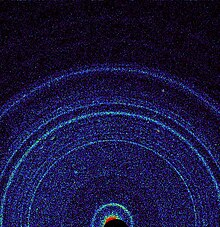
CheMin is the Chemistry and Mineralogy X-ray powder diffraction and fluorescence instrument.[120] CheMin is one of four spectrometers. It can identify and quantify the abundance of the minerals on Mars. It was developed by David Blake at NASA Ames Research Center and the Jet Propulsion Laboratory,[121] and won the 2013 NASA Government Invention of the year award.[122] The rover can drill samples from rocks and the resulting fine powder is poured into the instrument via a sample inlet tube on the top of the vehicle. A beam of X-rays is then directed at the powder and the crystal structure of the minerals deflects it at characteristic angles, allowing scientists to identify the minerals being analyzed.[123]
On October 17, 2012, at "Rocknest", the first X-ray diffraction analysis of Martian soil was performed. The results revealed the presence of several minerals, including feldspar, pyroxenes and olivine, and suggested that the Martian soil in the sample was similar to the "weathered basaltic soils" of Hawaiian volcanoes.[119] The paragonetic tephra from a Hawaiian cinder cone has been mined to create Martian regolith simulant for researchers to use since 1998.[124][125]
Sample Analysis at Mars (SAM)
The SAM instrument suite analyzes
Dust Removal Tool (DRT)
The Dust Removal Tool (DRT) is a motorized, wire-bristle brush on the turret at the end of Curiosity's arm. The DRT was first used on a rock target named Ekwir_1 on January 6, 2013. Honeybee Robotics built the DRT.[131]
Radiation assessment detector (RAD)
The role of the RAD instrument is to characterize the broad spectrum of radiation environment found inside the spacecraft during the cruise phase and while on Mars. These measurements have never been done before from the inside of a spacecraft in interplanetary space. Its primary purpose is to determine the viability and shielding needs for potential human explorers, as well as to characterize the radiation environment on the surface of Mars, which it started doing immediately after MSL landed in August 2012.
Dynamic Albedo of Neutrons (DAN)
The DAN instrument employs a neutron source and detector for measuring the quantity and depth of hydrogen or ice and water at or near the Martian surface.[134] The instrument consists of the detector element (DE) and a 14.1 MeV pulsing neutron generator (PNG). The die-away time of neutrons is measured by the DE after each neutron pulse from the PNG. DAN was provided by the
Mars Descent Imager (MARDI)

MARDI was fixed to the lower front left corner of the body of Curiosity. During the descent to the Martian surface, MARDI took color images at 1600×1200 pixels with a 1.3-millisecond exposure time starting at distances of about 3.7 km (2.3 mi) to near 5 m (16 ft) from the ground, at a rate of four
Robotic arm

The rover has a 2.1 m (6.9 ft) long
Two of the five devices are in-situ or contact instruments known as the X-ray spectrometer (APXS), and the Mars Hand Lens Imager (MAHLI camera). The remaining three are associated with sample acquisition and sample preparation functions: a percussion drill; a brush; and mechanisms for scooping, sieving, and portioning samples of powdered rock and soil.[141][143] The diameter of the hole in a rock after drilling is 1.6 cm (0.63 in) and up to 5 cm (2.0 in) deep.[142][145] The drill carries two spare bits.[145][146] The rover's arm and turret system can place the APXS and MAHLI on their respective targets, and also obtain powdered sample from rock interiors, and deliver them to the SAM and CheMin analyzers inside the rover.[142]
Since early 2015 the percussive mechanism in the drill that helps chisel into rock has had an intermittent electrical short.[147] On December 1, 2016, the motor inside the drill caused a malfunction that prevented the rover from moving its robotic arm and driving to another location.[148] The fault was isolated to the drill feed brake,[149] and internal debris is suspected of causing the problem.[147] By December 9, driving and robotic arm operations were cleared to continue, but drilling remained suspended indefinitely.[150] The Curiosity team continued to perform diagnostics and testing on the drill mechanism throughout 2017,[151] and resumed drilling operations on May 22, 2018.[152]
Media, cultural impact and legacy
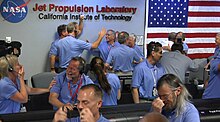

Live video showing the first footage from the surface of Mars was available at
On August 13, 2012, U.S. President Barack Obama, calling from aboard Air Force One to congratulate the Curiosity team, said, "You guys are examples of American know-how and ingenuity. It's really an amazing accomplishment."[153] (Video (07:20))
Scientists at the Getty Conservation Institute in Los Angeles, California, viewed the CheMin instrument aboard Curiosity as a potentially valuable means to examine ancient works of art without damaging them. Until recently, only a few instruments were available to determine the composition without cutting out physical samples large enough to potentially damage the artifacts. CheMin directs a beam of X-rays at particles as small as 400 micrometers (0.016 in)[159] and reads the radiation scattered back to determine the composition of the artifact in minutes. Engineers created a smaller, portable version named the X-Duetto. Fitting into a few briefcase-sized boxes, it can examine objects on site, while preserving their physical integrity. It is now being used by Getty scientists to analyze a large collection of museum antiques and the Roman ruins of Herculaneum, Italy.[160]
Prior to the landing, NASA and
NASA gave the general public the opportunity from 2009 until 2011 to submit their names to be sent to Mars. More than 1.2 million people from the international community participated, and their names were etched into silicon using an electron-beam machine used for fabricating micro devices at JPL, and this plaque is now installed on the deck of Curiosity.[162] In keeping with a 40-year tradition, a plaque with the signatures of President Barack Obama and Vice President Joe Biden was also installed. Elsewhere on the rover is the autograph of Clara Ma, the 12-year-old girl from Kansas who gave Curiosity its name in an essay contest, writing in part that "curiosity is the passion that drives us through our everyday lives."[163]
On August 6, 2013, Curiosity audibly played "Happy Birthday to You" in honor of the one Earth year mark of its Martian landing, the first time for a song to be played on another planet. This was also the first time music was transmitted between two planets.[164]
On June 24, 2014, Curiosity completed a
On August 5, 2017, NASA celebrated the fifth anniversary of the Curiosity rover mission landing, and related exploratory accomplishments, on the planet Mars.[18][19] (Videos: Curiosity's First Five Years (02:07); Curiosity's POV: Five Years Driving (05:49); Curiosity's Discoveries About Gale Crater (02:54))
As reported in 2018, drill samples taken in 2015 uncovered organic molecules of benzene and propane in 3 billion year old rock samples in Gale.[167][168][169]
Images
Components of Curiosity
-
Mast head with ChemCam, MastCam-34, MastCam-100, NavCam.
-
One of the six wheels on Curiosity
-
High-gain (right) and low-gain (left) antennas
-
UV sensor
Orbital images
-
Gale crater - surface materials (false colors; THEMIS; 2001 Mars Odyssey).
-
Curiosity's landing site is onMount Sharp(north is down).
-
Mount Sharprises from the middle of Gale; the green dot marks Curiosity's landing site (north is down).
-
Green dot is Curiosity's landing site; upper blue isMount Sharp.
-
Curiosity'slanding ellipse. Quad 51, called Yellowknife, marks the area where Curiosity actually landed.
-
Quad 51, a 1-mile-by-1-mile section of the crater Gale - Curiosity landing site is noted.
-
MSL debris field - parachute landed 615 m from Curiosity (3-D: rover & parachute) (August 17, 2012; MRO).
Rover images
-
Ejected heat shield as viewed by Curiosity descending to Martian surface (August 6, 2012).
-
Curiosity's first image after landing (August 6, 2012). The rover's wheel can be seen.
-
Curiosity's first image after landing (without clear dust cover, August 6, 2012)
-
Curiosity landed on August 6, 2012 near the base ofAeolis Mons (or "Mount Sharp")[170]
-
Curiosity's first color image of the Martian landscape, taken by MAHLI (August 6, 2012)
-
Curiosity's self-portrait - with closed dust cover (September 7, 2012).
-
Curiosity's self-portrait (September 7, 2012; color-corrected).
-
U.S. Lincoln penny on Mars (Curiosity; September 4, 2018)
-
Mount Sharp is visible in the background (MAHLI, September 9, 2012).
-
Curiosity's tracks on first test drive (August 22, 2012), after parking 6 m (20 ft) from original landing site[9]
-
Comparison ofAeolis Monson Mars (August 23, 2012)
-
Curiosity's view ofAeolis Mons (August 9, 2012; white-balanced image)
-
Layers at the base ofAeolis Mons. The dark rock in inset is the same size as Curiosity.
Self-portraits
Wide images

Legend: Active (white lined, ※) • Inactive • Planned (dash lined, ⁂) )
See also
- Astrobiology – Science concerned with life in the universe
- Autonomous robot – Robot that performs behaviors or tasks with a high degree of autonomy
- Experience Curiosity – Interactive web application
- Exploration of Mars – Overview of the exploration of Mars
- InSight – Mars lander, arrived November 2018
- Life on Mars – Scientific assessments on the microbial habitability of Mars
- List of missions to Mars
- Mars Express
- 2001 Mars Odyssey
- Mars Orbiter Mission – Indian space probe, launched in 2013
- Mars Pathfinder
- Mars Reconnaissance Orbiter
- Mars 2020 – Astrobiology Mars rover mission by NASA
- Opportunity rover
- Perseverance (rover)
- Rosalind Franklin rover
- Spirit rover
- Timeline of Mars Science Laboratory – Event timeline of the NASA Mars Science Laboratory mission
- Viking program – Pair of NASA landers and orbiters sent to Mars in 1976
References
- ^ Wall, Mike (August 6, 2012). "Touchdown! Huge NASA Rover Lands on Mars". Space.com. Retrieved December 14, 2012.
- ^ "Rover Fast Facts". NASA.
- ^ a b Nelson, Jon. "Mars Science Laboratory Curiosity Rover". NASA. Retrieved February 2, 2014.
- ^ "Curiosity: NASA's Next Mars Rover". NASA. August 6, 2012. Retrieved August 6, 2012.
- ^ Beutel, Allard (November 19, 2011). "NASA's Mars Science Laboratory Launch Rescheduled for Nov. 26". NASA. Retrieved November 21, 2011.
- ^ Martin, Paul K. (June 8, 2011). "NASA'S Management of the Mars Science Laboratory Project (IG-11-019)" (PDF). NASA Office of Inspector General. Retrieved August 6, 2012.
- ^ a b Abilleira, Fernando (2013). 2011 Mars Science Laboratory Trajectory Reconstruction and Performance from Launch Through Landing. 23rd AAS/AIAA Spaceflight Mechanics Meeting. February 10–14, 2013. Kauai, Hawaii.
- ^ a b Amos, Jonathan (August 8, 2012). "Nasa's Curiosity rover lifts its navigation cameras". BBC News. Retrieved June 23, 2014.
- ^ a b c d Brown, Dwayne; Cole, Steve; Webster, Guy; Agle, D.C. (August 22, 2012). "NASA Mars Rover Begins Driving at Bradbury Landing". NASA. Retrieved August 22, 2012.
- ^ a b "Video from rover looks down on Mars during landing". MSNBC. August 6, 2012. Retrieved October 7, 2012.
- ^ SkyandTelescope.com. Retrieved October 7, 2012.
- doi:10.1007/s11214-012-9879-z. Retrieved January 1, 2020.)
{{cite journal}}: Unknown parameter|displayauthors=ignored (|display-authors=suggested) (help - ^ "MSL Sol 3 Update". NASA Television. August 8, 2012. Retrieved August 9, 2012.
- ^ a b "Impressive' Curiosity landing only 1.5 miles off, NASA says". CNN. Retrieved August 10, 2012.
- ^ a b "Overview". JPL, NASA. Retrieved August 16, 2012.
- ^ a b c "Mars Science Laboratory: Mission Science Goals". NASA. August 2012. Retrieved August 21, 2012.
- ^ "Curiosity's mission extended indefinitely". 3 News NZ. December 6, 2012. Archived from the original on April 6, 2013. Retrieved December 5, 2012.
- ^ a b Webster, Guy; Cantillo, Laurie; Brown, Dwayne (August 2, 2017). "Five Years Ago and 154 Million Miles Away: Touchdown!". NASA. Retrieved August 8, 2017.
- ^ a b Wall, Mike (August 5, 2017). "After 5 Years on Mars, NASA's Curiosity Rover Is Still Making Big Discoveries". Space.com. Retrieved August 8, 2017.
- ^ Bosco, Cassandro (March 12, 2013). "NASA/JPL Mars Curiosity Project Team Receive 2012 Robert J. Collier Trophy" (PDF). National Aeronautic Association. Archived from the original (PDF) on February 23, 2014. Retrieved February 9, 2014.
- ^ "MSL Objectives". NASA.
- ^ Phillips, Tony (February 24, 2012). "Curiosity, The Stunt Double". NASA. Retrieved January 26, 2014.
- PMID 24458635.
- ^ "PIA16068". NASA.
- ^ a b Brown, Dwayne C.; Buis, Alan; Martinez, Carolina (May 27, 2009). "NASA Selects Student's Entry as New Mars Rover Name". NASA / Jet Propulsion Laboratory. Retrieved January 2, 2017.
 This article incorporates text from this source, which is in the public domain.
This article incorporates text from this source, which is in the public domain.
- ^ a b "MSL at a glance". CNES. Retrieved August 7, 2012.
- ^ a b Watson, Traci (April 14, 2008). "Troubles parallel ambitions in NASA Mars project". USA Today. Retrieved May 27, 2009.
- ^ Mars Rovers: Pathfinder, MER (Spirit and Opportunity), and MSL (video). Pasadena, California. April 12, 2008. Retrieved September 22, 2011.
- ^ "Mars Exploration Rover Launches" (PDF). NASA. June 2003. Archived (PDF) from the original on July 26, 2004.
- ^ a b c "Mars Science Laboratory (MSL): Mast Camera (MastCam): Instrument Description". Malin Space Science Systems. Retrieved April 19, 2009.
- ^ a b c "Mars Science Laboratory - Facts" (PDF). Jet Propulsion Laboratory, NASA. March 2012. Retrieved July 31, 2012.
- ^ a b c "Multi-Mission Radioisotope Thermoelectric Generator (MMRTG)" (PDF). NASA/JPL. October 2013. Archived from the original (PDF) on February 26, 2015. Retrieved December 26, 2017.
- ^ a b c "Mars Exploration: Radioisotope Power and Heating for Mars Surface Exploration" (PDF). NASA/JPL. April 18, 2006. Retrieved September 7, 2009.
- ^ Clark, Stephen (November 17, 2011). "Nuclear power generator hooked up to Mars rover". Spaceflight Now. Retrieved November 11, 2013.
- doi:10.1109/AERO.2004.1368101. Archived from the original(PDF) on December 16, 2011.
- ^ Campbell, Joseph (2011). "Fueling the Mars Science Laboratory" (PDF). Idaho National Laboratory. Archived from the original (PDF) on March 4, 2016. Retrieved February 28, 2016.
- ^ "Technologies of Broad Benefit: Power". NASA/JPL. Archived from the original on June 14, 2008. Retrieved September 20, 2008.
- ^ "Mars Science Laboratory – Technologies of Broad Benefit: Power". NASA/JPL. Retrieved April 23, 2011.
- ^ Misra, Ajay K. (June 26, 2006). "Overview of NASA Program on Development of Radioisotope Power Systems with High Specific Power" (PDF). NASA/JPL. Retrieved May 12, 2009.
- ^ a b c d e f g Makovsky, Andre; Ilott, Peter; Taylor, Jim (November 2009). Mars Science Laboratory Telecommunications System Design (PDF). DESCANSO Design and Performance Summary Series. Vol. 14. NASA/Jet Propulsion Laboratory.
- ^ a b Watanabe, Susan (August 9, 2009). "Keeping it Cool (...or Warm!)". NASA/JPL. Archived from the original on December 24, 2010. Retrieved January 19, 2011.
- ^ a b c d e "Mars Science Laboratory: Mission: Rover: Brains". NASA/JPL. Retrieved March 27, 2009.
- ISSN 0018-9162.
- ^ "BAE Systems Computers to Manage Data Processing and Command For Upcoming Satellite Missions" (Press release). BAE Systems. June 17, 2008. Archived from the original on September 6, 2008. Retrieved November 17, 2008.
- ^ "E&ISNow — Media gets closer look at Manassas" (PDF). BAE Systems. August 1, 2008. Archived from the original (PDF) on December 17, 2008. Retrieved November 17, 2008.
- ^ "RAD750 radiation-hardened PowerPC microprocessor" (PDF). BAE Systems. July 1, 2008. Retrieved September 7, 2009.
- ^ "RAD6000 Space Computers" (PDF). BAE Systems. June 23, 2008. Archived from the original (PDF) on October 4, 2009. Retrieved September 7, 2009.
- ^ Webster, Guy (March 4, 2013). "Curiosity Rover's Recovery on Track". NASA. Retrieved March 5, 2013.
- ^ Webster, Guy (March 25, 2013). "Curiosity Resumes Science Investigations". NASA. Retrieved March 27, 2013.
- ^ Gaudin, Sharon (August 8, 2012). "NASA: Your smartphone is as smart as the Curiosity rover". Computerworld. Retrieved June 17, 2018.
- ^ "Mars-Earth distance in light minutes". WolframAlpha. Retrieved August 6, 2012.
- ^ "Curiosity's data communication with Earth". NASA. Retrieved August 7, 2012.
- ^ "NASA's Curiosity Rover Maximizes Data Sent to Earth by Using International Space Data Communication Standards". Archived from the original on November 29, 2014. Retrieved January 2, 2013.
- ^ "ESA spacecraft records crucial NASA signals from Mars". Mars Daily. August 7, 2012. Retrieved August 8, 2012.
- ^ NASA Mars exploration efforts turn to operating existing missions and planning sample return. Jeff Foust, Space News. 23 February 2018.
- ^ "Next Mars Rover Sports a Set of New Wheels". NASA/JPL.
- ^ "Watch NASA's Next Mars Rover Being Built Via Live 'Curiosity Cam'". NASA. September 13, 2011. Retrieved August 16, 2012.
- ^ "New Mars Rover to Feature Morse Code". National Association for Amateur Radio.
- ^ Marlow, Jeffrey (August 29, 2012). "Looking Toward the Open Road". JPL - Martian Diaries. NASA. Retrieved August 30, 2012.
- ^ Lakdawalla, Emily (August 19, 2014). "Curiosity wheel damage: The problem and solutions". The Planetary Society Blogs. The Planetary Society. Retrieved August 22, 2014.
- ^ "First drive".
- ^ Gorman, Steve (August 8, 2011). "Curiosity beams Mars images back". Stuff - Science. Retrieved August 8, 2012.
- ^ a b "Mars Science Laboratory". NASA. Archived from the original on July 30, 2009. Retrieved August 6, 2012.
- ^ "Vandi Verma". ResearchGate. Retrieved February 7, 2019.
- ^ "Dr. Vandi Verma Group Supervisor". Jet Propulsion Laboratory. CIT. Retrieved February 8, 2019.
- ^ Estlin, Tara; Jonsson, Ari; Pasareanu, Carina; Simmons, Reid; Tso, Kam; Verma, Vandi. "Plan Execution Interchange Language (PLEXIL)" (PDF). NASA Technical Reports Server. Retrieved February 8, 2019.
- ^ "Bibliography of PLEXIL-related publications, organized by category". Plexil souceforge. Retrieved February 8, 2019.
- ^ "Main page: NASA applications". PLEXIL sourceforge. Retrieved February 8, 2019.
- ^ "Curiosity's Quad - IMAGE". NASA. August 10, 2012. Retrieved August 11, 2012.
- ^ Agle, DC; Webster, Guy; Brown, Dwayne (August 9, 2012). "NASA's Curiosity Beams Back a Color 360 of Gale Crate". NASA. Retrieved August 11, 2012.
- ^ Amos, Jonathan (August 9, 2012). "Mars rover makes first colour panorama". BBC News. Retrieved August 9, 2012.
- ^ Halvorson, Todd (August 9, 2012). "Quad 51: Name of Mars base evokes rich parallels on Earth". USA Today. Retrieved August 12, 2012.
- . Retrieved August 6, 2012.
- ^ "Gale Crater's History Book". Mars Odyssey THEMIS. Retrieved August 6, 2012.
- ^ Chang, Kenneth (October 5, 2015). "Mars Is Pretty Clean. Her Job at NASA Is to Keep It That Way". The New York Times. Retrieved October 6, 2015.
- ^ "Why NASA's Mars Curiosity Rover landing will be "Seven Minutes of Absolute Terror"". NASA. Centre National d'Etudes Spatiales (CNES). June 28, 2012. Retrieved July 13, 2012.
- ^ "Final Minutes of Curiosity's Arrival at Mars". NASA/JPL. Retrieved April 8, 2011.
- ^ Teitel, Amy Shira (November 28, 2011). "Sky Crane – how to land Curiosity on the surface of Mars". Scientific American. Retrieved August 6, 2012.
- ^ Snider, Mike (July 17, 2012). "Mars rover lands on Xbox Live". USA Today. Retrieved July 27, 2012.
- ^ "Mars Science Laboratory: Entry, Descent, and Landing System Performance" (PDF). NASA. March 2006. p. 7.
- ^ Amos, Jonathan (June 12, 2012). "NASA's Curiosity rover targets smaller landing zone". BBC News. Retrieved June 12, 2012.
- ^ "MSL Notebook - Curiosity Mars Rover data". an.rsl.wustl.edu. Retrieved April 20, 2020.
- ^ Amos, Jonathan (August 3, 2012). "Gale Crater: Geological 'sweet shop' awaits Mars rover". BBC News. Retrieved August 6, 2012.
- ^ a b c "MSL Science Corner: Sample Analysis at Mars (SAM)". NASA/JPL. Retrieved September 9, 2009.
- ^ "Overview of the SAM instrument suite". NASA. Archived from the original on February 22, 2007.
- Bibcode:2005LPI....36.1214M.
- ^ a b c d e "Mast Camera (MastCam)". NASA/JPL. Retrieved March 18, 2009.
- ^ a b c "Mars Hand Lens Imager (MAHLI)". NASA/JPL. Retrieved March 23, 2009.
- ^ a b c "Mars Descent Imager (MARDI)". NASA/JPL. Retrieved April 3, 2009.
- ^ Stern, Alan; Green, Jim (November 8, 2007). "Mars Science Laboratory Instrumentation Announcement from Alan Stern and Jim Green, NASA Headquarters". SpaceRef.com. Retrieved August 6, 2012.
- ^ Mann, Adam (August 7, 2012). "The Photo-Geek's Guide to Curiosity Rover's 17 Cameras". Wired. Retrieved January 16, 2015.
- ^ Klinger, Dave (August 7, 2012). "Curiosity says good morning from Mars (and has busy days ahead)". Ars Technica. Retrieved January 16, 2015.
- ^ "Mars Science Laboratory (MSL) Mast Camera (MastCam)". Malin Space Science Systems. Retrieved August 6, 2012.
- ^ David, Leonard (March 28, 2011). "NASA Nixes 3-D Camera for Next Mars Rover". Space.com. Retrieved August 6, 2012.
- ^ Bell III, J. F.; Maki, J. N.; Mehall, G. L.; Ravine, M. A.; Caplinger, M. A. (2014). Mastcam-Z: A Geologic, Stereoscopic, and Multispectral Investigation on the NASA Mars-2020 Rover (PDF). International Workshop on Instrumentation for Planetary Missions. November 4–7, 2014. Greenbelt, Maryland.
- ^ a b c d "MSL Science Corner: Chemistry & Camera (ChemCam)". NASA/JPL. Retrieved September 9, 2009.
- .
- PMC 1240923.
- ^ "ChemCam Status". Los Alamos National Laboratory. April 2008. Archived from the original on November 9, 2013. Retrieved August 6, 2012.
- ^ "Spacecraft: Surface Operations Configuration: Science Instruments: ChemCam". Archived from the original on October 2, 2006.
- ^ Vieru, Tudor (December 6, 2013). "Curiosity's Laser Reaches 100,000 Firings on Mars". Softpedia. Retrieved January 16, 2015.
- ^ "Rover's Laser Instrument Zaps First Martian Rock". 2012. Archived from the original on August 21, 2012. Retrieved August 20, 2012.
- ^ Webster, Guy; Agle, D.C. (August 19, 2012). "Mars Science Laboratory/Curiosity Mission Status Report". NASA. Retrieved September 3, 2012.
- ^ "'Coronation' Rock on Mars". NASA. Retrieved September 3, 2012.
- ^ Amos, Jonathan (August 17, 2012). "Nasa's Curiosity rover prepares to zap Martian rocks". BBC News. Retrieved September 3, 2012.
- ^ "How Does ChemCam Work?". ChemCam Team. 2011. Retrieved August 20, 2012.
- ^ a b "Mars Science Laboratory Rover in the JPL Mars Yard". NASA/JPL. Archived from the original on May 10, 2009. Retrieved May 10, 2009.
- ^ "First NavCam mosaic".
- Bibcode:2011mamo.conf..473G. Retrieved August 6, 2012.
- ^ a b "MSL Science Corner: Rover Environmental Monitoring Station (REMS)". NASA/JPL. Retrieved September 9, 2009.
- ^ "Mars Science Laboratory Fact Sheet" (PDF). NASA/JPL. Retrieved June 20, 2011.
- ^ a b c d e "Mars Science Laboratory: Mission: Rover: Eyes and Other Senses: Four Engineering Hazcams (Hazard Avoidance Cameras)". NASA/JPL. Retrieved April 4, 2009.
- ^ Edgett, Kenneth S. "Mars Hand Lens Imager (MAHLI)". NASA. Retrieved January 11, 2012.
- ^ "3D View of MAHLI Calibration Target". NASA. September 13, 2012. Retrieved October 11, 2012.
- ^ a b c "MSL Science Corner: Alpha Particle X-ray Spectrometer (APXS)". NASA/JPL. Retrieved September 9, 2009.
- ^ "40th Lunar and Planetary Science Conference" (PDF). 2009.
"41st Lunar and Planetary Science Conference" (PDF). 2010. - .
- ^ a b Brown, Dwayne (October 30, 2012). "NASA Rover's First Soil Studies Help Fingerprint Martian Minerals". NASA. Retrieved October 31, 2012.
- ^ "MSL Chemistry & Mineralogy X-ray diffraction(CheMin)". NASA/JPL. Retrieved November 25, 2011.
- .
- ^ Hoover, Rachel (June 24, 2014). "Ames Instrument Helps Identify the First Habitable Environment on Mars, Wins Invention Award". NASA. Retrieved June 25, 2014.
- ^ Anderson, Robert C.; Baker, Charles J.; Barry, Robert; Blake, David F.; Conrad, Pamela; et al. (December 14, 2010). "Mars Science Laboratory Participating Scientists Program Proposal Information Package" (PDF). NASA/Jet Propulsion Laboratory. Retrieved January 16, 2015.
- Bibcode:2007LPI....38.2005B. Retrieved April 28, 2014.
- ^ Allen, C. C.; Morris, R. V.; Lindstrom, D. J.; Lindstrom, M. M.; Lockwood, J. P. (March 1997). JSC Mars-1: Martian regolith simulant (PDF). Lunar and Planetary Exploration XXVIII. Archived from the original (PDF) on September 10, 2014. Retrieved April 28, 2014.
- .
- ^ a b "Sample Analysis at Mars (SAM) Instrument Suite". NASA. October 2008. Archived from the original on October 7, 2008. Retrieved October 9, 2009.
- ^ Tenenbaum, D. (June 9, 2008). "Making Sense of Mars Methane". Astrobiology Magazine. Retrieved October 8, 2008.
- PMID 17906720.
- .
- ^ Moskowitz, Clara (January 7, 2013). "NASA's Curiosity Rover Brushes Mars Rock Clean, a First". Space.com. Retrieved January 16, 2015.
- ^ a b "SwRI Radiation Assessment Detector (RAD) Homepage". Southwest Research Institute. Retrieved January 19, 2011.
- ^ "RAD". NASA.
- ^ "Laboratory for Space Gamma Spectroscopy - DAN". Laboratory for Space Gamma Spectroscopy. Archived from the original on May 21, 2013. Retrieved September 20, 2012.
- ^ "MSL Science Corner: Dynamic Albedo of Neutrons (DAN)". NASA/JPL. Retrieved September 9, 2009.
- PMID 18598140.
- ^ "Mars Science Laboratory: Mission". NASA JPL. Retrieved August 6, 2012.
- ^ "Mars Descent Imager (MARDI) Update". Malin Space Science Systems. November 12, 2007. Retrieved August 6, 2012.
- ^ "Junocam, Juno Jupiter Orbiter". Malin Space Science Systems. Retrieved August 6, 2012.
- ^ Anderson, Paul Scott (February 3, 2013). "Curiosity 'hammers' a rock and completes first drilling tests". themeridianijournal.com. Archived from the original on February 6, 2013. Retrieved February 3, 2013.
- ^ a b "Curiosity Rover - Arm and Hand". JPL. NASA. Retrieved August 21, 2012.
- ^ a b c Jandura, Louise. "Mars Science Laboratory Sample Acquisition, Sample Processing and Handling: Subsystem Design and Test Challenges" (PDF). JPL. NASA. Retrieved August 21, 2012.
- ^ JPL. NASA. August 21, 2012. Archived from the originalon August 22, 2012. Retrieved August 21, 2012.
- ^ Billing, Rius; Fleischner, Richard. "Mars Science Laboratory Robotic Arm" (PDF). MDA US Systems. Archived from the original (PDF) on October 6, 2016. Retrieved January 22, 2017.
{{cite journal}}: Cite journal requires|journal=(help) - ^ a b "MSL Participating Scientists Program - Proposal Information Package" (PDF). Washington University. December 14, 2010. Retrieved August 21, 2012.
- ^ Billing, Rius; Fleischner, Richard (2011). "Mars Science Laboratory Robotic Arm" (PDF). 15th European Space Mechanisms and Tribology Symposium 2011. Retrieved August 21, 2012.
- ^ a b Clark, Stephen (December 29, 2016). "Internal debris may be causing problem with Mars rover's drill". Spaceflight Now. Retrieved January 22, 2017.
- ^ "NASA Is Trying to Get Mars Rover Curiosity's Arm Unstuck". Popular Mechanics. Associated Press. December 13, 2016. Retrieved January 18, 2017.
- ^ Wall, Mike (December 15, 2016). "Drill Issue Continues to Afflict Mars Rover Curiosity". Space.com. Retrieved February 10, 2018.
- ^ "Sols 1545-1547: Moving again!". NASA Mars Rover Curiosity: Mission Updates. NASA. December 9, 2016.
- ^ Lakdawalla, Emily (September 6, 2017). "Curiosity's balky drill: The problem and solutions". The Planetary Society. Retrieved February 10, 2018.
- ^ Curiosity Rover is Drilling Again. David Dickinon, Sky and Telescope. 4 June 2018.
- ^ New York Times. Retrieved August 14, 2012.
- ^ "Curiosity Lands on Mars". NASA TV. Archived from the original on August 6, 2012. Retrieved August 6, 2012.
- ^ "NASA's Mars Rover Crashed Into a DMCA Takedown". Motherboard. Motherboard.vice.com. August 6, 2012. Archived from the original on August 8, 2012. Retrieved August 8, 2012.
- ^ "Huge Crowds Watched NASA Rover Land on Mars from NYC's Times Square". Space.com. Retrieved August 8, 2012.
- ^ "Mars Rover 'Mohawk Guy' a Space Age Internet Sensation | Curiosity Rover". Space.com. August 7, 2012. Retrieved August 8, 2012.
- ^ "Mars landing proves memes now travel faster than the speed of light (gallery)". VentureBeat. June 18, 2012. Retrieved August 8, 2012.
- ^ Boyer, Brad (March 10, 2011). "inXitu co-founder wins NASA Invention of the Year Award for 2010" (PDF) (Press release). InXitu. Archived from the original (PDF) on August 3, 2012. Retrieved August 13, 2012.
- ^ "Martian rover tech has an eye for priceless works of art". August 10, 2012. Retrieved August 13, 2012.
- ^ Thomen, Daryl (August 6, 2012). "'Mars Rover Landing' with Kinect for the Xbox 360". Newsday. Retrieved August 8, 2012.
- ^ "Send Your Name to Mars". NASA. 2010. Retrieved August 7, 2012.
- ^ "NASA's Curiosity rover flying to Mars with Obama's, others' autographs on board". collectSPACE. Retrieved August 11, 2012.
- Washington Post. Retrieved August 7, 2013.
- ^ Webster, Guy; Brown, Dwayne (June 23, 2014). "NASA's Mars Curiosity Rover Marks First Martian Year". NASA. Retrieved June 23, 2014.
- ^ Harwood, William (December 4, 2012). "NASA announces plans for new $1.5 billion Mars rover". CNET. Retrieved December 5, 2012.
Using spare parts and mission plans developed for NASA's Curiosity Mars rover, the space agency says it can build and launch a new rover in 2020 and stay within current budget guidelines.
- ^ Chang, Kenneth (June 7, 2018). "Life on Mars? Rover's Latest Discovery Puts It 'On the Table'". The New York Times. Retrieved June 8, 2018.
The identification of organic molecules in rocks on the red planet does not necessarily point to life there, past or present, but does indicate that some of the building blocks were present.
- PMID 29880670.
- PMID 29880683.
- ^ PhysOrg. Retrieved August 16, 2012.
- ^ Bodrov, Andrew (September 14, 2012). "Mars Panorama - Curiosity rover: Martian solar day 2". 360Cities. Retrieved September 14, 2012.
External links
- Curiosity Rover - Home Page - NASA/JPL
- MSL - NASA Updates - *LIVE* TBA Schedule (NASA-TV) (NASA-Audio)
- The search for life on Mars & elsewhere in the Solar System: Curiosity update - Video lecture by Christopher P. McKay
- MSL - Curiosity Design and Mars Landing - PBS Nova (2012-11-14) - Video (53:06)
- MSL - "Curiosity 'StreetView'" (Sol 2 - 2012-08-08) - NASA/JPL - 360° Panorama
- MSL - Curiosity Rover - Learn About Curiosity - NASA/JPL
- MSL - Curiosity Rover - Virtual Tour - NASA/JPL
- MSL - NASA Image Gallery
- Weather Reports from the Rover Environmental Monitoring Station (REMS)
- Curiosity on X
- MSL - NASA Update - AGU Conference (2012-12-03) Video (70:13)
- Panorama (via Universe Today)

Legend: Active (white lined, ※) • Inactive • Planned (dash lined, ⁂) )


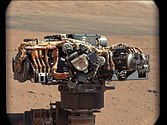
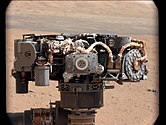
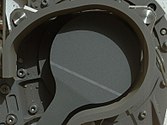
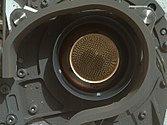






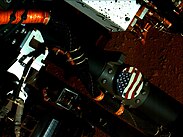
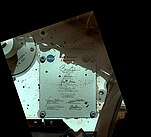
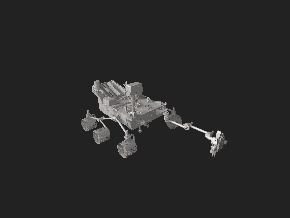




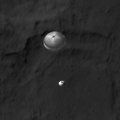












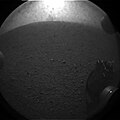

![Curiosity landed on August 6, 2012 near the base of Aeolis Mons (or "Mount Sharp")[170]](http://upload.wikimedia.org/wikipedia/commons/thumb/6/65/673885main_PIA15986-full_full.jpg/120px-673885main_PIA15986-full_full.jpg)

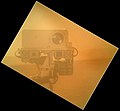





![Curiosity's tracks on first test drive (August 22, 2012), after parking 6 m (20 ft) from original landing site[9]](http://upload.wikimedia.org/wikipedia/commons/thumb/6/63/PIA16094-Mars_Curiosity_Rover-First_Drive_Tracks.jpg/120px-PIA16094-Mars_Curiosity_Rover-First_Drive_Tracks.jpg)

















